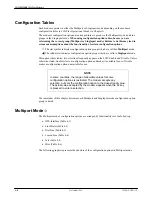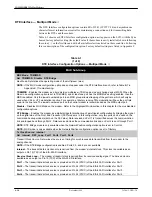
DCP Configuration
4-15
3920-A2-GN31-30
November 1996
Table 4-1
(6 of 9)
DTE Interface Configuration Options — Multiport Mode
l
RTS Action: Stndrd_RS232
Nxt Stndrd_RS232 Ignore Sim_Cntl_Car
Request-to-Send Action. RTS is a signal from the DTE indicating the DTE has data to send.
Standard RS232 – Allows the DTE to control RTS to the modem in normal EIA-232-D operation. RTS must be ON for
the DTE to transmit to the modem.
Ignore – Modem assumes RTS is always ON. Use this selection when the DTE does not provide RTS to the modem.
Simulated Control Carrier – RTS input controls the remote modem’s LSD signal. This is used for DTEs that require
Line Signal Detect (LSD) to toggle ON and OFF to simulate half-duplex operation. If RTS Action is set to simulated
control carrier, then the remote modem’s LSD Control configuration option must be set to Simulated Control Carrier.
Simulated Control Carrier conforms to V.13 specifications. This setting is ignored when the modem is configured for
Asynchronous mode and RTS/CTS flow control is selected.
NOTE: Simulated Control Carrier is not available on point-to-point MSD ports.
NOTE: Simulated Control Carrier is available on TMp tributary ports for dial backup purposes.
RTS Antistream: Disabled
Nxt 10msec 30msec 1min 2min 3min 5min
This configuration option only appears when MSD is enabled, or when RTS Action is set to Sim_Cntl_Car.
Request-to-Send Antistreaming. If enabled, the operation of the antistreaming function is as follows. If RTS is ON for a
period exceeding the selected time, the modem will take over control of the carrier and will force the carrier OFF. The
modem will also force CTS OFF during this time. This condition will stay in effect until the DTE turns RTS OFF. After
this, the next time the DTE turns RTS ON, carrier will be turned ON and the RTS timer will start again.
Disable – The antistreaming function is not in effect.
10 sec, 30 sec, 1 min, 2 min, 3 min, 5 min – Enables the antistreaming function and sets the maximum ON time for
RTS before antistreaming control takes effect.
CTS Control: Stndrd_RS232
Nxt Stndrd_RS232 Forced_On WinkWhenDisc Follows_DTR Follows_RTS
Clear-to-Send Control. CTS is a signal from the modem to the DTE indicating that it can accept data from the DTE.
Standard RS232 – In Synchronous mode, forces the state of CTS to follow the state of RTS in normal EIA-232-D
operation. The minimum time that elapses between CTS and RTS is determined by the RTS/CTS Delay configuration
option. Use this setting for most synchronous applications.
Forced On – CTS is forced ON at all times. Use this selection for most asynchronous applications.
Wink When Disconnect – CTS is normally forced ON, but is turned OFF for 1 to 2 seconds upon a disconnect.
Follows DTR – The state of CTS follows the state of DTR. When DTR turns ON, CTS turns ON. When DTR turns OFF,
CTS turns OFF.
Follows RTS – The state of CTS follows the state of RTS. When RTS turns ON, CTS turns ON. When RTS turns OFF,
CTS turns OFF.
















































